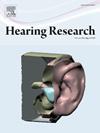Eye movement-related eardrum oscillations do not require current visual input
IF 2.5
2区 医学
Q1 AUDIOLOGY & SPEECH-LANGUAGE PATHOLOGY
引用次数: 0
Abstract
Oculomotor signals influence the neural processing of auditory input. Recent studies have shown that this connection extends to the auditory periphery: The phase and amplitude of eardrum oscillations was systematically influenced by eye movement direction and magnitude, a phenomenon called eye movement-related eardrum oscillations (EMREOs). Previous findings have suggested that EMREOs occur independently from auditory stimulation, but it is unknown whether they depend on the presence of visual sensory input or solely reflect efference copies of the oculomotor system. To distinguish between these two alternatives, we measured eye movements and eardrum oscillations in sighted human participants who performed free saccadic eye movements in darkness. Despite the lack of any sensory stimulation during eye movements, significant EMREOs occurred in all participants. EMREO characteristics were comparable to a separate control experiment in which participants performed guided saccades to visual targets and were robust to different types of eye tracker calibration methods. Thus, our results suggest that EMREOs are not driven by bottom-up sensory signals but rather reflect a pure influence of oculomotor signals on peripheral auditory processing. This indicates that EMREOs might play a crucial role in reference frame transformations which are needed for audio-visual spatial integration.
眼动相关的耳膜振荡不需要当前的视觉输入
眼动信号影响听觉输入的神经加工。最近的研究表明,这种联系延伸到听觉外围:耳膜振荡的相位和振幅系统地受到眼动方向和幅度的影响,这种现象称为眼动相关耳膜振荡(EMREOs)。先前的研究结果表明,emreo独立于听觉刺激而发生,但尚不清楚它们是否依赖于视觉感觉输入的存在,还是仅仅反映了动眼肌系统的输出拷贝。为了区分这两种选择,我们测量了在黑暗中进行自由跳眼运动的视力正常的人类参与者的眼球运动和耳膜振荡。尽管在眼球运动过程中缺乏任何感官刺激,但所有参与者都出现了显著的emreo。EMREO特征与单独的对照实验相当,在对照实验中,参与者对视觉目标进行引导扫视,并且对不同类型的眼动仪校准方法具有鲁棒性。因此,我们的研究结果表明emreo不是由自下而上的感觉信号驱动的,而是反映了眼动信号对周围听觉加工的纯粹影响。这表明emreo可能在视听空间整合所需的参照系转换中发挥关键作用。
本文章由计算机程序翻译,如有差异,请以英文原文为准。
求助全文
约1分钟内获得全文
求助全文
来源期刊

Hearing Research
医学-耳鼻喉科学
CiteScore
5.30
自引率
14.30%
发文量
163
审稿时长
75 days
期刊介绍:
The aim of the journal is to provide a forum for papers concerned with basic peripheral and central auditory mechanisms. Emphasis is on experimental and clinical studies, but theoretical and methodological papers will also be considered. The journal publishes original research papers, review and mini- review articles, rapid communications, method/protocol and perspective articles.
Papers submitted should deal with auditory anatomy, physiology, psychophysics, imaging, modeling and behavioural studies in animals and humans, as well as hearing aids and cochlear implants. Papers dealing with the vestibular system are also considered for publication. Papers on comparative aspects of hearing and on effects of drugs and environmental contaminants on hearing function will also be considered. Clinical papers will be accepted when they contribute to the understanding of normal and pathological hearing functions.
 求助内容:
求助内容: 应助结果提醒方式:
应助结果提醒方式:


